Nothing can bring the past to life like costumed historic interpreters surrounded
with the personal goods and tools of an earlier age. Artefacts that seem puzzling
when seen in a museum exhibit or book suddenly become clear when seen in actual
use, or in placed directly in your hand. Your questions are answered when you
can speak directly with someone acting as a 'voice from the past'.
Some 1000 years ago, the first Europeans to explore North America would travel
from Greenland to what they called Vinland (modern day Newfoundland). These Norse
of the Viking Age were not the raiders of legend, but instead farmers, fishermen
and bold sailors. At today's L'Anse aux Meadows, at the tip of the Northern Peninsula,
they built sturdy turf walled houses to over winter, and most certainly explored
further into the Gulf of St Lawrence region.
The Dark Ages Recreation Company (DARC) is inviting those interested in history
to come visit us as we illustrate daily life during the Viking Age. This special
presentation is hosted by Parks Canada, as an extension of its regular living
history programing at L'Anse aux Meadows NHSC. This year marks the 50th anniversary
of the discovery of the site of 'Leif's Houses' by Helge and Anna Stine Ingstad.
A featured event over DARC's 10 day presentation will be reconstruction and firing
of the original iron smelting furnace (Saturday August 21).
Who are DARC?
The Dark Ages Re-creation Company was formed in 2000. Members of DARC are drawn
from throughout Central Ontario, and are serious amateur living history enthusiasts,
most with decades of experience. DARC has provided skilled and well equipped interpreters
for special programs for all of the major events and exhibitions that marked the
'Viking Millennium' in Canada. No other group of Canadian re-enactors has as much
accumulated museum experience. As a group and as individuals, members have worked
both throughout Canada and the USA. Personal research has taken members to museums
and archaeological sites across Iceland, the United Kingdom and Scandinavia. DARC
has once again been invited by Parks Canada to come and demonstrate at L'Anse
aux Meadows NHSC in Newfoundland.
DARC focuses on daily life in the Viking Age. The presentation will centre on
a 'camp', with costumed interpreters surrounded by a collection of replica objects
consisting of domestic goods, tools, and storage. Individuals will be outfitted
with the tools of their various trades and arts, all representing our real interests
and skills. (We really are weavers and cooks, blacksmiths and carvers.) All of
the objects seen, from clothing to tents, are based on specific artifact prototypes.
To the public, the members of DARC present themselves as actual voices from the
past, with shared experiences and direct interactions as a group. Individual members
of DARC have prepared detailed characterizations based on their personal research
into the Viking Age, developing considerable expertise in specialized areas. These
characters are the 'common man': artisans, merchants or farmers typical of the
Norse of the North Atlantic circa 1000 AD. Any conversation is likely to begin
at this 'role playing' level of historic interpretation. The interpretive level
used is then shifted to suit the needs of individual visitors. Some people delight
in talking to a character from 1000 years ago, others are more comfortable with
more of a modern commentary. The experienced interpreters of DARC are able to
handle a wide range of topics and level of detail.
The Scenario:
The Althing in Iceland of 1000 was an important one. As always, many disputes
were heard and settled, to the gain of some and loss of others. One of the significant
decisions made at the Althing was to encourage all Icelanders to accept Christianity.
This did not sit well with all. As always, many things were discussed and deals
made away from the Speaker's Rock. Some came just to be seen, traders and artisans
came to display their wares, seeking customers and commissions at the gathering.
The days of the Landham were long gone, so good (even acceptable) farm land had
pretty much all been settled. Knowing this, minor chieftains were becoming less
and less likely to even oath to new bondi, and not very generous if they would.
The famine years were now just a distant memory to only the oldest Icelanders,
but still the land was not as bountiful as it once was. One exciting piece of
news at the Althing was that of Eric the Red's new Green Land, and even mention
of his son Lief's Vinland, both to the west.
There was a man named Ragnarr Thorbergsson, once from Kaupang in Norway. He had
come to Iceland, hoping to improve his status and increase his trading. Now Ragnarr
was well known for this weather luck, but not so envied for his luck in travel.
His voyages never were outright disasters, but certainly things just never turned
out as he boasted they would.
Ragnarr's schemes at the Althing did not worked as he had planned. He was certainly
not alone in this. There were recent immigrants to Iceland, and even young families
and second sons, all of whom found that there was no chance of good farm land
in their future. There were some who felt the conversion to the new religion was
just not to their taste. As always, there were those who felt a fresh start in
a new land would solve what ever problems that always seemed to plague them.
So Ragnarr, nothing if not shrewd, quickly hired a ship to sail to Greenland.
He gathered up a load of the hopeful and disgruntled who would pay him passage
against the chance to settle on new farms of their own. As it happened, things
didn't go perfectly on the voyage, with the ship blown off course. Like Bjarni
before them, they found themselves near Vinland. Knowing the tales freshly told,
they found their way to Leif's bu<eth>ir and found some Greenlanders already
there. Most were not pleased to find that they would need to lay over the winter
before continuing to Greenland in the spring.
This mixed group of farmers and craftsmen, of varied ages and original homelands,
now finds themselves stuck together in close quarters in Vinland. They are settling
in to the outpost best they can, and trying to help get ready for the winter soon
to come. The ship and most of the crew has gone off down the coast to harvest
valuable timber, hoping to improve their lot when they finally make it to Greenland.
Planned Daily Activities:
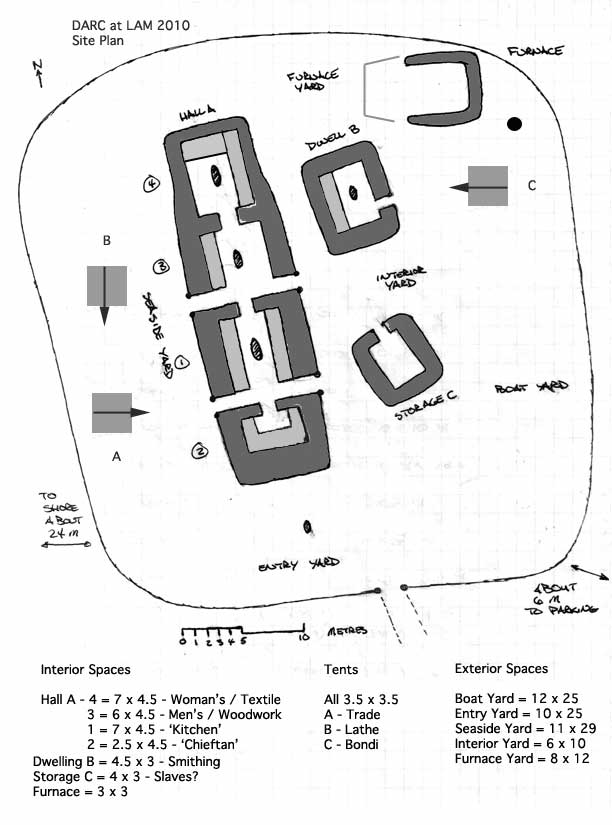
Tent A - Introduction, Trade, Gaming
- Ragnar Thorbergsson / Neil Peterson
Ragnar, who styles himself a man of influence, will welcome you to the Encampment.
In his fine tent, he displays a selection of the trade goods he has brought from
Iceland and beyond. He also may invite you into a game of hnefatafal (Kings Table).

Tent B - Spring Pole Lathe, Green Woodworking, Music
- Rig Erlisson / Richard Schwetizer
- Grimbold Thorbjornson / David Cox
Rig, a man of considerable energy, has set up a simple spring pole lathe. On hearing
wood will be in short supply in Greenland, he is doing his best to take advantage
of the timber available in Vinland while here. Using axes and other simple tools,
he is splitting out planks and bench tops, and working some pieces up into simple
bowls. Son of an Icelandic skald, he also continues his father's tradition in
music and Saga telling.
Grimbold is a man with good all round skills in camp. He is likely to be found
almost any place an extra set of hands is required.
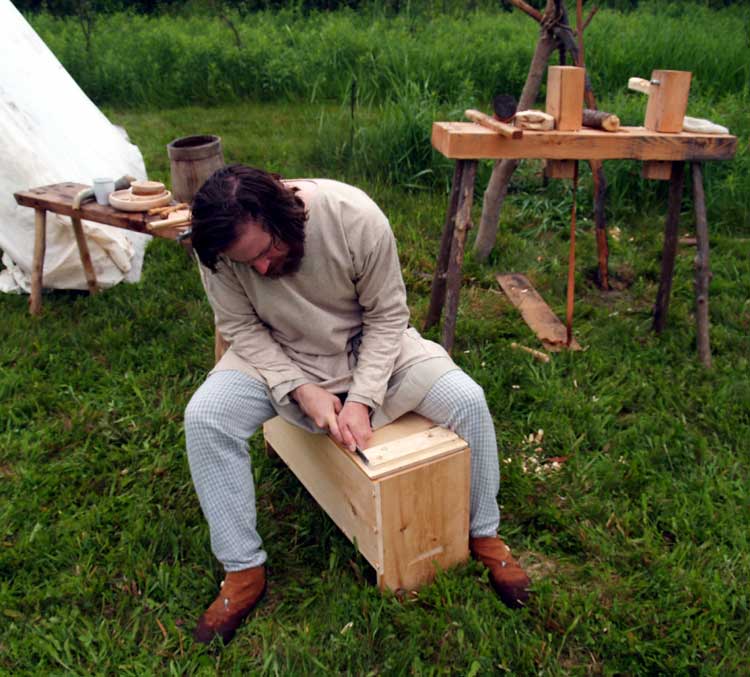
Main Hall 3 (Men's Workroom) - Wood carving, Leatherworking, Antler &
Bone Carving, Music
- Thorgeirr Mikjállson / Marcus Burnahm
- Thorgrimir Gunnarsson / Steve Strang
Thorgir, like many Norse farmers, has many basic skills. Originally from near
Jorvik (York) in England, he has brought a better than average set of woodworking
tools along to help him establish his new farmstead in Greenland. He also has
a well earned reputation as a shoe maker, and repairs keep him busy.
Thorgrimir, one of the older members of the group, is quite well known for his
skills as a fine carver in antler and bone. He also is a fine musician, if not
quite the teller of tales that Rig is.
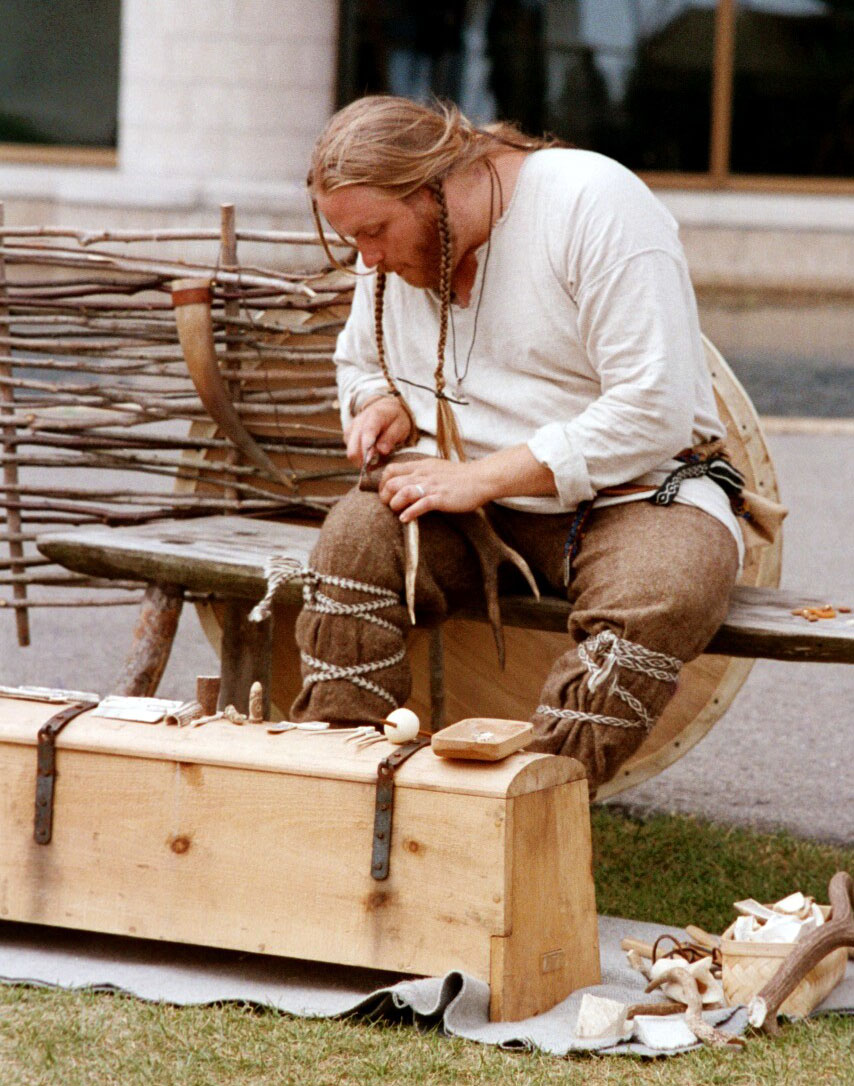
Main Hall 4 (Women's Workroom) - Weaving, Spinning, Naelbinding, Tablet
Weaving
- Ka∂lín Jónsdottir / Karen Davidson
- Jorunn Roidatter / Josephine Duke
- Audr Grimsdottir / Diane Harper
- Hrobjartr Skegglaus / Robert Schweitzer
Ka∂lin, wife to Ragnar, is an accomplished weaver, and not very happy about
the disruption the diversion to Vinland has caused. Even still, she is attempting
to organize the women into a team to transform what sheep's fleece is available
into useable cloth. She is still trying to get to used to her new warp weighted
loom, made from local birch.
Jorunn, accompanied by her youngest daughter Katla, is a typical Norse farm wife.
She is often found helping with weaving and spinning, along with all the other
varied tasks required around hearth and home.
Audr, as a widow in the somewhat chaotic Erlisson household, contributes many
fine textile skills. She prefers to leave the heavier labour of weaving to the
younger women, and so is often found spinning, naelbinding (single needle knitting)
or sewing. Farm life in Iceland has resulted in her skills in net work as well,
which she may be found engaged in over at the Bondi tent.
Hrobjartr, with his fine skills in complex tablet weaving, is often the subject
of jokes from the other men. His nickname Skegglau, 'the beardless' being one
sign of this. Still, there is no doubting by any that his work producing ornate
straps or bands of trim are not of the very highest quality.
Dwelling House - Food Preparation
- Bera Surtrsdøttir / Vandy Simpson
Bera, also called Quick Finger for her skill at weaving, has taken on the task
of cooking for the group. She is widely praised for her knowledge and skills in
food preparation, but perhaps does wish someone else had that reputation! Despite
Vinland being such a remote outpost, there is actually a quite different range
of foods available here than there was back in Iceland.

Interior Yard - Domestic Work, Dyeing
- Kadja / Kary Bates
Kadja is the sole female slave in the group, bound to Ketil and Bera. This really
does not effect her life all that much sharing as a minor member of the household,
save for being last to eat and poorest clothed. Her daily round consists of the
heavier domestic tasks such as hauling water and wood, washing clothes and the
like. She is also tasked with keeping a low fire under the dye pot.

Bondi Tent - Basketry, Net work
- Aesa / Sarah Scroggie
With her two year old son Emundr to manage, Aesa seems more than normally distracted.
Expect to find her often involved with simple children's games. Even still, she
is attempting to work some of the local Vinland materials into much needed storage
baskets. Living the life of a poorer 'Bondi' (bound man), her accommendations
are in sharp contrast to those seen around Ragnar!
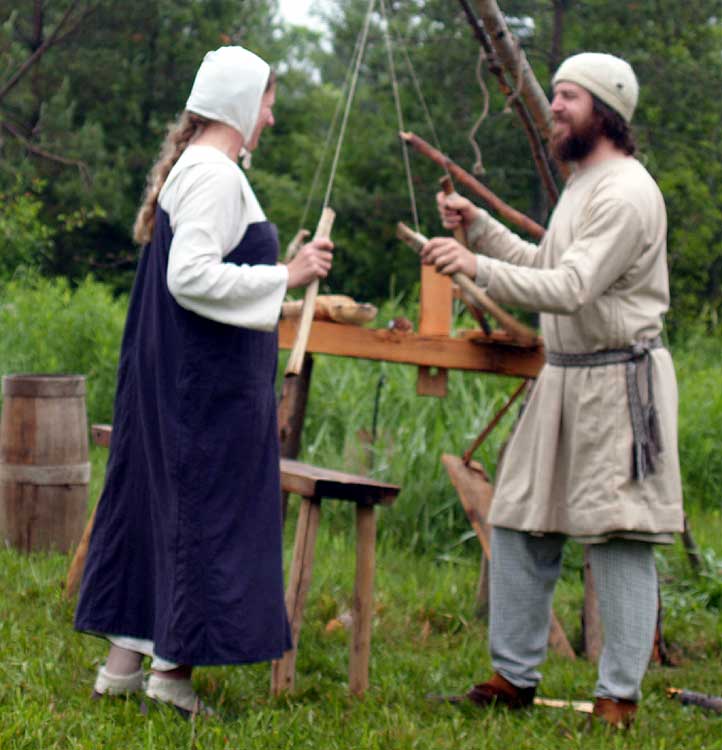
Furnace Hut - Iron Smelting
- Ketil Einarsson / Darrell Markewitz
- Grettr Blackhands / Ken Cook
Ketil brings experience as a blacksmith to Vinland, working with Grettr as his
assistant. Over the week they will be preparing all the materials, then building
an iron smelting furnace. Intended as a test of the local bog ore, firing this
furnace to produce a bloom of iron will take an entire day (Saturday 21st).
Experimental Archaeology Demonstrations
To expand your understanding of the world of the Norse, a series of specially
scheduled demonstrations is planned. These include many activities not part of
the cycle of life in Vinland, but still common to the Viking Age. Held mid afternoons,
at and around the Visitor's Centre.
Glass Bead Making
It turns out the exact methods used by Norse craftsmen to take pieces of imported
glass and make colourfull glass beads are still unknown. Learn with us as we build
an operate a charcoal fired furnace and manipulate hot glass.
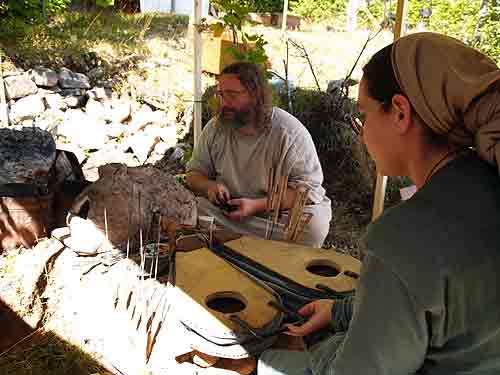
Metal Casting
The Norse were renouned as skilled metal workers. Techniques for casting bronze
will be illustrated, and pewter will be cast into soapstone molds in this demonstration.

Coin Minting
One of the big changes during the Viking Age was the increased use of silver coins
for purchasing, replacing the older barter system in the new trade towns. See
how silver pennies were made and discuss just how money was spent 1000 years ago.

Bog Iron Ore
Just what *is* this stuff? Where do you find it? Did you know that the purity
of bog iron ore can be estimated by *eating* it? Join us as we hunt along Black
Duck Brook, just as the Norse did, looking for some of this valuable resource.
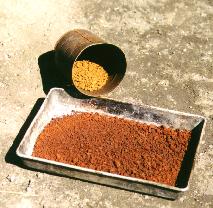
Iron Smelt Evaluation
Many of the details of the production of iron at Vinland by the Norse are unknown.
The demonstration smelt by DARC is actually part of an ongoing scientific process.
Just what is Experimental Archaeology, and how does it work. On Sunday, August
22, join the DARC smelt team as they record and evaluate the iron smelt of the
day before.
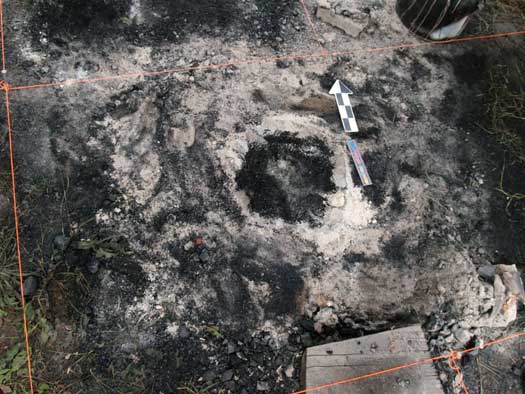
|

